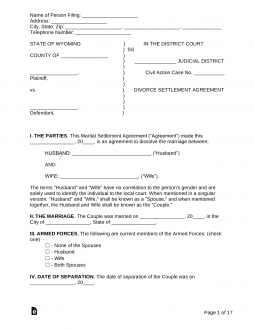Updated August 30, 2023
A Wyoming marital settlement agreement is used by married couples to come to an agreement regarding the details of their divorce. The property division, child custody, and spousal/child support decisions will all be detailed in the completed document and signed by both parties to present the judge with an agreed-upon settlement. It is recommended that both parties obtain legal counsel when negotiating the terms of the agreement to ensure a just and equitable division of assets and responsibility.
Table of Contents |
Divorce Laws
Statutes – Title 20, Chapter 2 (Dissolution of Marriage)
Alimony (§ 20-2-114) – The court may order either party to pay the other alimony (spousal support) as a lump sum, for a set period of time, or indefinitely. The amount of alimony and the duration of payment will be based on what is deemed just and fair in consideration of the distributing party’s ability to pay.
Child Support (Article 3 – Child Support) – Child support is calculated using the combined income of both parents (child support table found in § 20-2-304(a)). The court may deviate from the table in consideration of the following (as listed in § 20-2-307(b)):
- The age of the child;
- Daycare costs;
- Special healthcare or educational costs;
- Either parent’s existing child support of other children;
- The value of services provided by either parent;
- Pregnancy expenses;
- Transportation costs;
- Employment benefits;
- Amount of time spent with each parent;
- Any additional expenses contributed for the benefit of the child;
- Whether either party is voluntarily underemployed;
- The children’s impact on either parent’s earning capacity;
- Employability of either parent and availability of employment;
- Wage rates in local area;
- Any violations of a divorce decree;
- Any other factor deemed relevant by the court.
Division of Property (§ 20-2-114) – Wyoming is an equitable distribution state, meaning that the court will divide the property as they deem just and fair. This distribution is in contrast to that of a community property state, wherein all marital property is divided evenly between spouses.
Grounds for Divorce (§ 20-2-104 and § 20-2-105) – Wyoming is a no-fault state; this means that the couple need only prove that there are irreconcilable differences between them in order to obtain a divorce decree. The exception lies in cases where a party can be proven to be incurably insane or has resided in a mental hospital for a period of at least two (2) years.
Interim Support (§ 20-2-111) – The court may order either party to pay the other temporary support while the divorce case is pending.
Residency (§ 20-2-107) – A divorce may be granted only if one (1) of the spouses has resided in the state for at least sixty (60) days prior to filing the complaint, or the couple was married in the state and the filing party has lived in Wyoming from the time of the marriage until the filing of the complaint.
Divorce Forms
- Where to File – District Court
- Filing Fee – Varies by county but approx. $60 (source: 3stepdivorce.com)
- How Long Does it Take? – 30-90 days (source: 3stepdivorce.com)
Uncontested Divorce with No Children:
- Civil Cover Sheet
- Vital Statistics Form
- Complaint for Divorce
- Summons
- Acknowledgement and Acceptance of Service
- Answer to Complaint for Divorce (no Children)
- Answer and Counterclaim for Divorce (no Children)
- Initial Disclosures (Plaintiff)
- Initial Disclosures (Defendant)
- Reply to Counterclaim
- Affidavit for Divorce Without Appearance of Parties
- Decree of Divorce
- Request for Setting
- Order Setting Hearing
Uncontested Divorce With Children:
- Civil Cover Sheet
- Vital Statistics Form
- Complaint for Divorce (with Children)
- Summons
- Confidential Statement of Parties for Child Support
- Answer to Complaint for Divorce (with Children)
- Answer and Counterclaim to Complaint for Divorce (with Children)
- Confidential Financial Affidavit
- Initial Disclosures (Plaintiff)
- Initial Disclosures (Defendant)
- Reply to Counterclaim
- Affidavit for Divorce Without Appearance of Parties
- Decree of Divorce (with Children)
- Order for Income Withholding
- Income Withholding for Support
- Request for Setting
- Order Setting Hearing
The below instructions are for divorces wherein both parties agree on all terms including child support, property division, and alimony. While there is no legal requirement to file a Marital Settlement Agreement with the clerk of the District Court, the couple may choose to draft an agreement nonetheless. They can submit it to the judge and the court may use the terms therein to edit and add to the final divorce decree.
How to File for Divorce in Wyoming (10 steps)
- Complete Divorce Paperwork
- File Forms with District Court
- Defendant Served
- Defendant Answer
- Initial Disclosures
- Parenting Classes (if applicable)
- Complete Final Paperwork
- Request Hearing
- Attend Hearing
- Name Change
1. Complete Divorce Paperwork

In a divorce case, there is a plaintiff (the individual filing the complaint) and a defendant (the other party to answer the complaint). If the spouses are filing together, they can choose which of them will file and which will answer. The plaintiff will be required to download, complete, and sign the below documents. They’ll also want to make two (2) copies of each.
- Civil Cover Sheet
- Vital Statistics Form
- Complaint for Divorce (with children|without children)
- Summons
- Confidential Statement of Parties for Child Support (if spouses have children)
2. File Forms with District Court

Once completed and copied, the plaintiff can take the forms down to the District Court in the county where either they or their spouse live. They’ll need to pay the filing fee (varies by county) and submit the forms to the clerk. The clerk will keep the original, the plaintiff will keep a copy for themselves, and they’ll keep a copy to serve on the defendant.
3. Defendant Served
4. Defendant Answer

The defendant, if they live in state, will have twenty (20) days in which to complete and file their answer and, if applicable, their counterclaim. If they live out of state, they’ll be given thirty (30) days. They’ll have to make three (3) copies, file one with the court, keep one for themselves, and mail one to the plaintiff.
- Answer to Complaint for Divorce (no Children)
- Answer and Counterclaim for Divorce (no Children)
- Answer to Complaint for Divorce (with Children)
- Answer and Counterclaim to Complaint for Divorce (with Children)
The defendant, if they share minor children with the plaintiff, will also be required to file with the court a Confidential Financial Affidavit and all necessary attachments (i.e., tax returns).
6. Parenting Classes (if applicable)
7. Complete Final Paperwork
- Confidential Financial Affidavit (if spouses have children)
- The defendant will have to file this form as well. Plaintiff will need to complete the document and attach all necessary income verification.
- Reply to Counterclaim
- If the defendant filed a counterclaim with their answer, the plaintiff will need to complete and file this form within twenty (20) days of the counterclaim being filed.
- Decree of Divorce (with children|without children)
- Both parties will need to sign the divorce decree indicating that they are in agreement with the terms therein. They can use the Marital Settlement Agreement to help draft and to file in conjunction with the decree.
- Affidavit for Divorce Without Appearance of Parties (with children|without children)
- Can be used and filed if the parties have reached an agreement, which in this case, they have.
- Order for Income Withholding (if spouses have children)
- An order that will be signed by the judge if approved ordering a party to pay child support.
- Income Withholding for Support (if spouses have children)
- An order requiring the obliger’s employer or other income provider to withhold a percentage of their income for child support.
- Certification of Parenting Course (if spouses have children)
- This certification is only required in certain counties. The plaintiff should check with the court clerk while filing their complaint to see if such a course is required of them.
Not all of the above documents are required in all cases. The plaintiff will have to make two (2) copies of the necessary forms and file them with the court with envelopes addressed to their and the defendant’s addresses. These envelopes will be used to mail copies of the Divorce Decree if the judge approves the paperwork.


